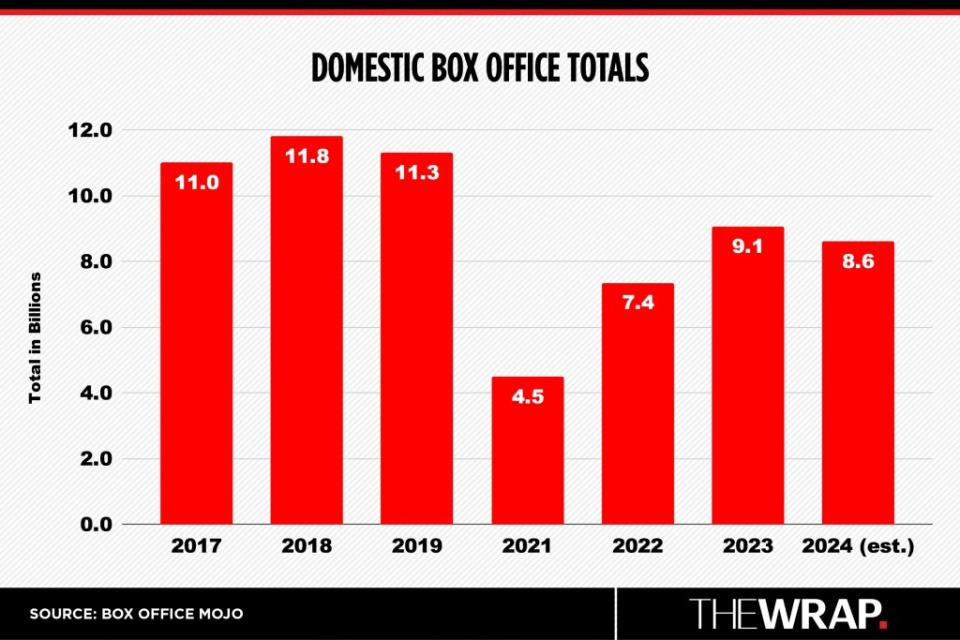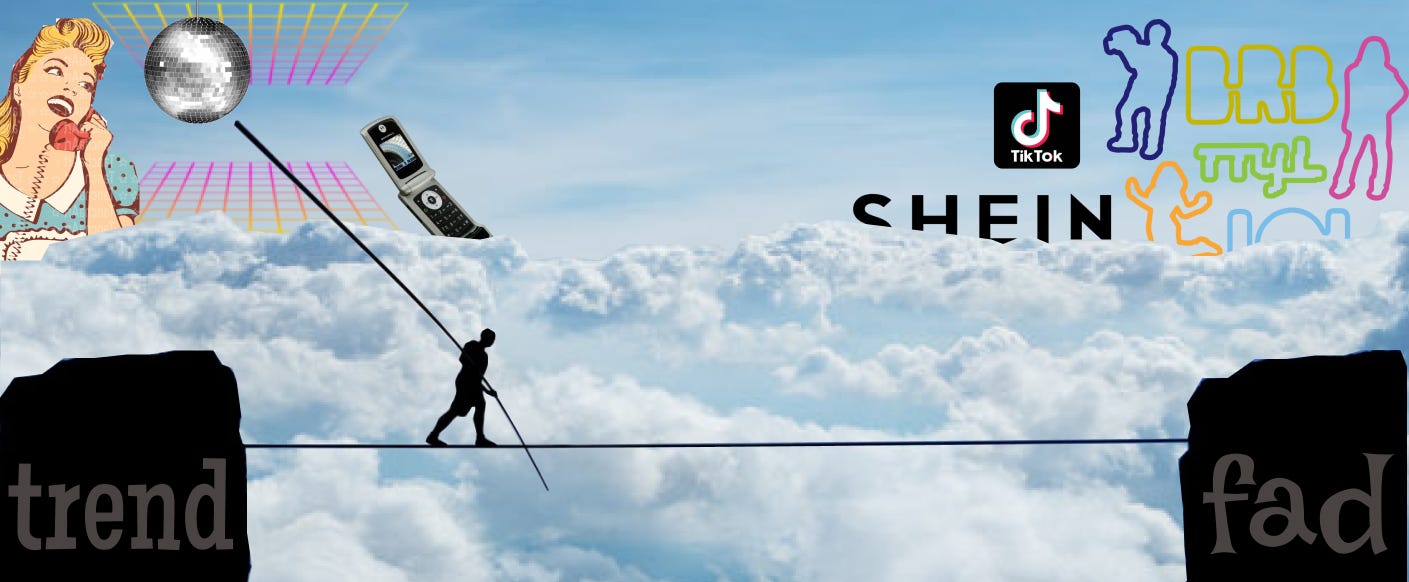The Fine Line Between Fad and Trend
The two are not synonymous!
Fad and trend are oftentimes confused. Many of today’s perceived trends are actually glorified fads, telling us everything we need to know about the direction we’re headed in society.
trend: A gradual and sustained shift in behavior, style, or culture that grows in popularity over time and often has a lasting impact. Trends evolve based on deeper societal, technological, or economic factors and can influence industries for years.
fad: A short-lived burst of popularity driven by hype or novelty. It often fades quickly as people move on to the next big thing. Fads tend to lack long-term staying power because they don't usually fulfill a deeper need or solve a meaningful problem. - ChatGPT
Trends shape culture
Not only do trends shape culture, they define it. What trends create is impact and rippling effects. Trends are catalysts for influence while fads fizzle out. They arise from the depths of social change and reflect the evolving values and interests of culture. Think back to the 80s and a clear image of culture-defining trends appear: disco, neon, roller skates, pop-rock, leg warmers, CD and walkmans, MTV, Jane Fonda…
Trends have power to redefine human interaction and our perception of the world.
Today we see many technology-driven trends. The digital age influences how we spend our free time and where we consume. Work-from-home was a trend, and now an expected norm for many of us when applying to/working at a job. The effect of the remote-work trend is increased productivity and redefinition of how efficient we can be with our day.1 In the future, we’ll see new trends become our way-of-life due to the advancements in AI. Already, generative AI is beginning to shift our habits in everyday work. AI-generated content and virtual assistants are altering how we consume media and engage with digital spaces.
Let’s go back to the mid-1900s. While subtle, the household adoption of the fully autonomous dish washer and laundry machine had immense rippling effects on society. A traditionally female-driven household chore became automated, allowing for women to have more free time and find careers. Now, women are outperforming men in the workforce and are more efficient. A trend for buying autonomous products was revolutionary to increasing our economic growth and reimagining gender roles.
Trends are indicators of cultural evolution, continuously molding societal values. Whether gradual or disruptive, trends leave a lasting impact, transforming society.
Decreasing windows of attention
Fads on the other hand, leave no lasting impact and are detrimental to society’s progression. While technology has driven the rise of trends, unfortunately it has also perpetuated the craze of fads and put us in a vicious cycled relationship between fads and lowered attention spans.
The trend cycle now only lasts weeks or months before being replaced. The film industry is experiencing this struggle firsthand. With content made for long form, how can they cater to our decreasing attention spans? An unsustainable solution they’ve adopted is to shorten the theatrical window for films before going on-demand. What used to be the traditional 90-day period a film showed in theaters before going to video on demand (VOD), has now become 30. That may seem like a non-issue, the films are still feature-length, 120-minute pieces of work. But in reality, the cause for doing so is a reaction to our limited attention spans. A theater forces you to be fully present, highly discouraging outside distractions from interrupting the movie-going experience. When you watch VOD, you can have as many distractions as you’d like while still consuming the film. It’s more convenient for us and our way of life, and detrimental to the theater industry which:
Over 3,000 theaters have closed nationwide
Theater audiences have declined 33% since 2019
Box office revenue has dropped by $3B comparing 2024 to 2019 data

Social media platforms like TikTok, Instagram, and Twitter have accelerated the life cycle of trends, turning virality into a measure for cultural success. Internet challenges, dance trends, and memes dictate what captures public attention, creating a need to consume shorter and shorter form content. The rapid consumption of content, driven by algorithms designed to maximize engagement, has created an environment for fads to flourish. Advertisements as a result have gotten shorter, and “successful” videos are said to only capture our attention in the first 3 seconds. For fear of being left in the noise of media and being scrolled by, companies feed the beast of fads and dig us deeper into this attention-shrinking hole. The “cultural moments” they say they’re creating are more akin to one-hit wonders, generating a pop in interest and quickly fizzling out.
Fads run the world
Our decreasing attention span reinforces the fad craze. Fads are more dominant than ever before. They’re sneaky as the pose under the guise of trends, making them normalized for wide adoption. In technology, media, fashion, health (pretty much every profit-driven industry), we are induced with fad-driven content. The intention many times is to maximize profit in the short-run, leading to instability in our markets and overconsumption of resources. In a cynical view, we are becoming the reflection of Thomas Malthus’ society in An Essay on the Principle of Population. Fads feed our craving for stimuli and consumption but leave little to no value and impact.
Thomas Malthus' An Essay on the Principle of Population (1798) argues that human population grows exponentially while food production increases only arithmetically. This imbalance, he claimed, would lead to resource shortages, famine, and societal collapse unless population growth was controlled. -ChatGPT
Industries struggle to balance long-term sustainability with relevancy in a society driven by viral moments. Social media “trends” (really majority are fads) have only reinforced the need to jump on the fad bandwagon for relevancy. For consumers, it’s become more difficult to distinguish between trends that have lasting cultural impact and short-lived fads. Reflecting on fads, we probably have some nostalgia associated with them, but no real change was initiated as a result. As a kid in the 2000s the one that comes to mind is silly bandz. No significance in culture was made from their popualrity.2 One side effect of TikTok fads is the fast fashion industry profiting off short-term crazes. Fast fashion, and now ultra fast fashion, uses fads to abuse the fashion supply chain and moving us closer to Malthus’ reality.
Not to be overly dramatic, but fads are one of if not the main driver for the breakdown of the fabrics holding up our culture (very dramatic).
Having a trend mentality
Trend mentality entails being mindful of the future. It embodies the intentionality to recognize new behaviors and connections between people, having perspective on the big picture and acting on it. Rather than being fixated on the fleetingness of fads, a trend mentality sees the future impact of what’s “in”. Contrary to the beliefs on longevity and sustainability, trends are actually good for society. Real trends eventually become a widely accepted cultural norm and are more synonymous to sustainability than we may believe. Take any invention, let’s use cell phones, and you’ll see the foresight the inventor(s) had to bring about new trends with the future in mind. This forward-thinking mentality doesn’t choose to capitalize on the present but invests in the sustainability of their concept.
Thinking with the long term in mind is almost always the right choice, in business, in love, in life.
Productivity here referencing total utility a person has including: work productivity, personal growth, leisure time, household labor, and parenting/care.
Silly bandz while a fleeting phase, probably created some deep subculture for silly bandz loyalists and collectors. I still stand by stance, but the existence of subculture is fascinating. I briefly wrote on it here if you want to read more :)


